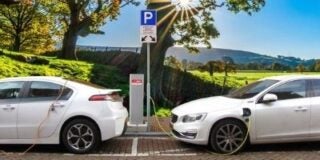- Resources
- Driving the electric vehicle transition: auto companies and states step up to lead
Resources
Driving the electric vehicle transition: auto companies and states step up to lead
Published: April 30, 2021 by Taylor Bacon
This piece was originally posted on Climate 411.
If you watched any major televised sporting events this year, from the NCAA Final Four to the Super Bowl, you saw ad after ad showcasing American auto companies’ new electric cars. It’s proof that electric vehicles (EVs) are ready for a mainstream market – you don’t pay Will Ferrell and LeBron James to promote your car just to niche buyers.
Momentum is clearly building. Companies are prepared to capitalize on the economic benefits of EVs, for both consumers and autoworkers, as well as the climate and health benefits that all Americans will see.
In the last three months, some of the largest automakers in the U.S. and the world have committed to dramatically expanding their EV lineup. They have announced plans to invest billions of dollars in EV development, and plans to transition to an all-electric future by 2035 or earlier.
The Biden administration made a commitment last week to reduce U.S. climate pollution by at least 50 percent by 2030 – a commitment that was supported by major automakers and that will require significant emission reductions from the transportation sector.
States are also playing a leading role in driving progress. Last week, a bipartisan group of 12 governors detailed the important role that states have played in deploying zero-emitting vehicles and urged the Biden administration to move forward with ambitious standards that would eliminate pollution from all motor vehicles. And next week, the California Air Resources Board will hold a workshop related to its development of Advanced Clean Car II standards – standards that are expected to help the state ensure all new vehicles sold in California are zero-emitting by 2035.
The transportation sector is responsible for over a quarter of U.S. climate pollution – more than any other sector. The transportation sector also emits a slew of health-harming pollutants, including oxides of nitrogen and particulate pollution. The transportation sector is key to meaningful climate action.
To achieve meaningful reductions in transportation pollution, it will be key for the administration follow automakers’ commitments and state leadership with bold, decisive air pollution standards that put the U.S. on a path to ensure all new vehicles are zero-emitting no later than 2035 for passenger cars and trucks, and no later than 2040 for freight trucks and buses.
Automakers are making significant climate commitments
Major automakers are making serious climate commitments through investment in EV development, ambitious target setting, and calling for federal climate action.
Ford
- In June 2020, Ford expanded its climate change goals and set a target to be carbon neutral by 2050.
- Ford recently applauded California’s bold commitment to make all new cars sold in the state zero-emitting by 2035.
- In February 2021, Ford announced its plan to invest $22 billion in electrification through 2025, nearly doubling its previous commitment.
- Ford also committed that by 2030 its entire European passenger vehicle line will be all-electric.
General Motors
- General Motors, the largest U.S. automaker, plans to spend $27 billion to launch 30 EVs globally by the end of 2025.
- GM has committed to carbon neutrality in global products and operations by 2040, with an aspiration to eliminate tailpipe emissions from new light-duty vehicles by 2035.
- Recently, GM announced that it will be manufacturing an electric version of the Chevrolet Silverado with a range of over 400 miles at Factory ZERO in Detroit and Hamtramck.
Volvo
- In the beginning of March 2021, Volvo upped their goal of climate neutrality by 2040 with plans to go fully electric by 2030, selling only battery electric vehicles.
- Volvo is aiming for half of its sales to be electric cars and half to be hybrids by 2025.
Honda
- In April 2021, Honda set a goal of all electric vehicle (including fuel cell vehicles) sales by 2040.
Coalitions
- In November 2020, 28 businesses launched the Zero Emission Transportation Association (ZETA) to advocate for policies to advance 100% zero-emission vehicles by 2030. The group is comprised of car, truck, and bus manufacturers like Tesla, Rivian, and Arrival; major power companies, including Duke Energy and Southern Company; ride-share companies like Uber; charging station companies like ChargePoint; raw materials manufacturers, and more.
- Other coalitions including ChargEVC, Corporate Vehicle Alliance (CEVA), and EV100 are bringing together hundreds of automakers, businesses, and advocacy groups to accelerate the transition to EVs.
Together, GM and Ford accounted for more 30% of light-duty car sales in the U.S. in 2020. They are also two of the top five largest global automakers, which shows just how influential their commitments can be toward a goal of eliminating pollution from cars and trucks around the world.
Both companies also signed onto the We Mean Business Coalition letter, which called on the Biden administration to set a target of a 50% reduction in greenhouse gas emissions by 2030 – reductions that the transportation sector will play an important role in securing.
Freight Trucks and Buses
- On the medium and heavy-duty side, seven of the largest truck manufacturers in Europe – Daimler, Scania, MAN, Volvo, DAF, IVECO, and Ford – have committed to phasing out diesel trucks by 2040.
- Daimler trucks aims to sell carbon neutral commercial vehicles in all their markets, including North America, by 2039.
- Navistar, Tesla, Volvo Trucks, U.K.-based Arrival, Daimler Trucks North America, and Mercedes all have plans to build or upgrade U.S. plants for the production of electric trucks and vans.
Electrifying the transportation sector will save lives, create jobs, and bolster the economy
These commitments from automakers have the potential to create immense positive change when paired with protective air pollution standards.
An EDF report released earlier this year examined the benefits associated with pollution standards and complementary societal investments that ensure all new cars and passenger trucks sold by 2035 are zero-emitting. By 2040, these pollution safeguards will reduce annual climate pollution by 600 million metric tons and prevent 5,000 premature deaths each year from reductions in smog and particulate pollution. By 2050, this will translate into a total of 98,000 lives saved.
On the economic side, these safeguards will deliver more than $100 billion in net societal benefits each year and provide $1.6 trillion in cumulative net benefits to Americans by 2050.
Electrifying freight trucks and buses can similarly offer enormous climate and health benefits. Eliminating tailpipe pollution from these vehicles by 2040 would reduce nitrogen oxides pollution, which contributes to smog, by more than 450,000 tons. It would also reduce particulate pollution by nearly 9,000 tons. These pollution reductions would prevent as many as 57,000 premature deaths through 2050, and generate up to $485 billion in health and environmental benefits alone.
An April M.J. Bradley report found that automakers worldwide will spend $268 billion through 2030 developing new electric car models, including more than $22 billion to open new or renovated plants in the U.S.
The electric vehicle industry (hybrid electric vehicles, plug-in hybrid vehicles, and electric vehicles) employed over 250,000 people across the U.S. in 2020, according to E2. This is the fastest-growing sector in terms of clean energy employment, growing more than 26% between 2017 and 2020. With new or expanding electric vehicle plants planned across the country – from Austin and San Antonio, Texas to Lordstown, Ohio to towns all over Michigan – the transition to EVs can mean adding thousands of new, well-paying jobs for Americans.
(EDF has also released a fact sheet that has key takeaways from the M.J. Bradley report. You can find that here).
Automakers commitments and state leadership must be paired with national pollution standards
Producing all zero-emitting vehicles is critical in combatting climate and health-harming pollution from the transportation sector, but they are not enough by themselves. The U.S. must take advantage of this window of opportunity to put in place transformative, multipollutant standards for cars, freight trucks, and buses.
Eliminating climate and health-harming pollution from the transportation sector must also be paired with societal investments, like those in President Biden’s American Jobs Plan. That will help to ensure these new vehicles support domestic manufacturing and American jobs. It’s also critical that the deployment of EVs is carried out with a strong equity and justice lens to ensure broad access to zero-emitting vehicles, and to ensure that pollution reductions are secured in the neighborhoods that have historically borne the brunt of transportation pollution.
It’s time to act
Almost two-thirds of voters support U.S. automakers transitioning to zero-emission vehicles. Fifteen states are on track to adopt, or have adopted, California’s Clean Car Standards.
We now need strong leadership from the Biden administration to adopt ambitious pollution standards that eliminate pollution from new passenger vehicles by 2035 and from medium- and heavy-duty vehicles by 2040. That will allow us to secure the immense benefits that zero-emitting vehicles have to offer.

